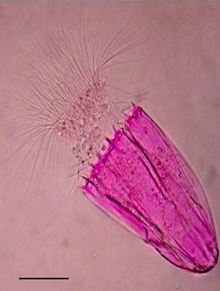Spinoloricus cinziae
| Spinoloricus nov. sp. | |
|---|---|

| |
| Scientific classification | |
| Kingdom: | |
| Phylum: | |
| Genus: | |
| Species: | S. nov. sp.
|
| Binomial name | |
| Spinoloricus nov. sp. | |
Spinoloricus nov. sp. is an undescribed species in the phylum Loricifera. It has been called "Spinoloricus Cinzia" in the lay press[1] so there is an indication that its scientific name could be Spinoloricus cinzia.
It is the first animal species to be named that does not require oxygen at any point during its life.[2][3] The species, along with two other newly discovered species, Rugiloricus nov. sp. and Pliciloricus nov. sp., were found in the sediment of the anoxic L'Atalante basin of the Mediterranean Sea.[2][3]
Electron microscope images[4] show that the species' cellular innards appear to be adapted for a zero-oxygen life. Their cells appear to be lacking mitochondria, which use oxygen to generate energy in other animals. Instead, the species appears to possess hydrogenosomes, organelles which provide energy in some anaerobic single-celled creatures.[5]
With a visual resemblance to tiny cups with tentacles sticking out, the species has been said to look like something out of a Dr. Seuss book.[5]
See also
References
- ^ Jackson P. (8 April 2010). http://news.bbc.co.uk/2/hi/8609246.stm "First oxygen-free animals found". BBC News. accessed 16 April 2010.
- ^ a b New species 'live without oxygen', The Telegraph, April 9, 2010
- ^ The first metazoa living in permanently anoxic conditions. BMC Biology 2010, 8:30.
- ^ a b Multicelled Animals May Live Oxygen-Free, U.S. News & World Report, April 12, 2010
